Complete DMA Workflow

What is Kmbox?
The KMbox (Keyboard & Mouse Emulation Box) is a hardware device commonly used in DMA (Direct Memory Access) cheat setups to automate or enhance keyboard/mouse inputs in games while evading anti-cheat detection. Unlike software-based input tools, the KMbox mimics physical peripherals at the hardware level, making it harder for anti-cheat systems like EasyAntiCheat, BattlEye, or Vanguard to detect suspicious activity.Role in DMA Cheats
Hardware-Level Input Emulation
The KMbox acts as a bridge between the Second PC (Cheat PC) (running cheat software) and the Gaming PC. It converts digital commands (e.g., recoil control scripts, rapid-fire macros) into hardware-level keyboard/mouse signals, making inputs appear as if they originate from a legitimate peripheral.Integration with DMA
- The DMA card reads game memory data (e.g., player positions, weapon stats) from the gaming PC.
- The cheat PC processes this data and sends instructions to the KMbox, which executes the inputs on the gaming PC.
- This separation ensures the gaming PC never runs cheat software directly, reducing detection risks.
Key Features
| Feature | Description |
|---|---|
| Anti-Detect Inputs | Emulates human-like mouse movements and keystrokes, bypassing software-level anti-cheat scans. |
| Macro Scripting | Supports custom scripts for recoil control, rapid fire, auto-loot, or building (e.g., Fortnite). |
| Plug-and-Play | No drivers required; works via USB passthrough or network (Wi-Fi/ETH models). |
| Cross-Platform | Compatible with PC, PlayStation, Xbox, and even mobile devices via adapters. |
| Low Latency | Sub-1ms response time for real-time input execution (critical for competitive gaming). |
Common Use Cases
- Recoil Control: Automatically adjusts mouse movements to counteract weapon recoil patterns (e.g., CS2, Apex Legends).
- Aimbot Assistance: Smooths aim movements toward targets (when paired with DMA-based ESP data).
- Rapid Fire: Bypasses fire-rate limits in semi-automatic weapons.
- Automated Actions: Triggers keystrokes for repetitive tasks (e.g., looting, building).
Setup in a DMA Cheat System
Hardware Connections
- Gaming PC → Connected to KMbox via USB.
- KMbox → Linked to Second PC (Cheat PC) via USB, Wi-Fi, or Ethernet (depending on model).
- DMA Card → Installed in the Main PC to read gaming PC memory.
Software Configuration
- Load custom scripts (e.g., Lua/Python) into the KMbox’s firmware.
- Sync DMA data (e.g., enemy coordinates) with input scripts for dynamic adjustments.
Example Workflow
- DMA card detects an enemy’s position via memory reading.
- Cheat PC calculates optimal aim trajectory.
- KMbox translates this into mouse movements on the gaming PC.
Advantages Over Software Tools
- Undetectable by Design: Operates at the hardware level, avoiding memory scans or kernel-level anti-cheat checks.
- Versatility: Works with consoles and PCs, unlike DMA-only setups.
- Customization: Scripts can be fine-tuned for specific games or playstyles.
Limitations
- Complexity: Requires scripting knowledge to maximize effectiveness.
- Firmware Risks: Kmbox firmware is not open source, so there is no way to obtain custom firmware. (The official provides routine firmware updates every month)
Popular KMbox Models
- KMbox A: Very old version, use for basic script control.
- KMbox B + / B Pro+: On the market for over three years, this product has recently been detectable by several anti-cheat systems due to its use of a COM port.
- KMbox Network: Based on the Kmbox B+ upgrade, it has been modified to use a network port to control the host, which is much safer and more stable compared to the B series.
- KMbox NVideo: Basically its a Kmbox Network + Built-in capture card. More often used with AI products.
Comparison to Similar Tools
| Tool | Detection Risk | Input Customization | DMA Compatibility |
|---|---|---|---|
| KMbox | Very Low | High | Yes |
| Arduino | Low | Moderate | Yes |
| AutoHotkey | High | High | No |
